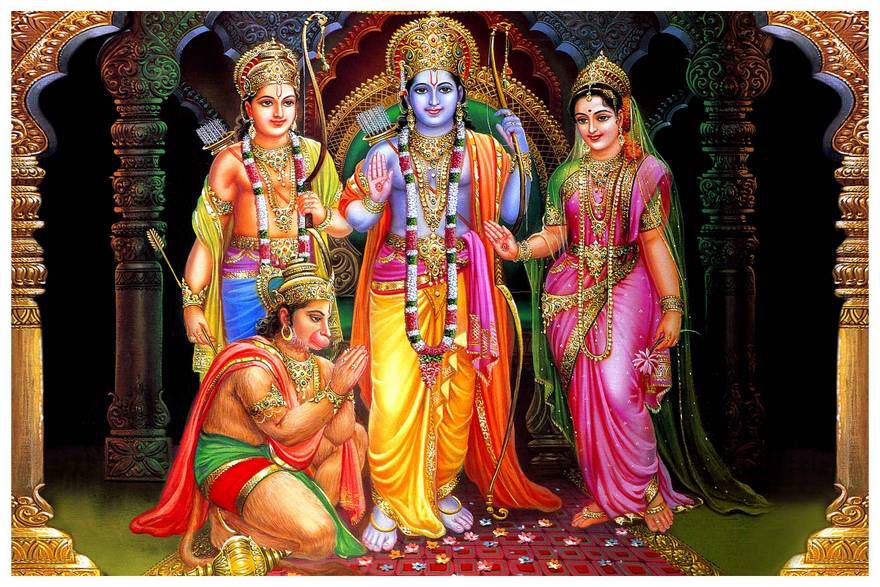Leadership lessons from Rama

Today is SriRamaNavami, celebrated as the birthday of Rama.
The Ramanaya(Rama’s Journey) Epic is the best action/thriller/romantic/emotional/family drama featuring the most handsome hunk Rama(Ajanubahum , Aravinda Dalaya Taksham) as the hero, the beautiful Sita (lacks metaphors to describe her beauty) as the heroine, the arrogant Ravana as the villain, and Lakshmana, Hanuman, and others as supporting actors.
The director started writing Rama’s Journey with the intent of teaching various life lessons to humankind with lots of devotion and finally he had to divide it into seven parts: Bala kanda, Ayodhya kanda, Aranya kanda, Kishkinda Kanda, Sundara Kanda, Yuddha Kanda, and Uttara Kanda. Each Kanda deals with a particular period of Rama’s life.
As Winston Churchill said, “Those that fail to learn from history, are doomed to repeat it.” We should strive to learn many leadership characteristics and gain motivation from role model Rama.
Lead by example:
Being an eldest son, he set an example to be obedient and to respect elders.
Dasaratha(The king himself) was devastated by Kaikeyi’s request to impose a fourteen year exile on Rama. Even though there was a myriad of other ways as which this could be bypassed, Rama chose to uphold the truth and preserve dharma and left for the forest. Leaders should also take tough decisions that are in the long-term interest based on ethical values and not over short-term gains.
Rama is hailed as the very embodiment of truth and dharma. By choosing Sugriva over Vaali (though Vaali could have been a logical choice as Vaali is a powerful king and defeated Ravana in the past), he teaches us to follow moral and ethical beliefs even during crisis.
Rama is the head of the army in the war against Raavan and he was always ready to provide directions to his army. He taught the world that true leader is the one who leads from the front.
Rama was a transformational leader who inspired followers and helped them grow into leaders by empowering them. Rama helped Sugriva and Vibheeshana to establish their own kingdoms.
Clarity in vision:
Rama has clear vision to rescue Sita and establish Dharma in the kingdom. Rama also clearly shared his vision with his team. This clarity helped his army to put their best fight until they could achieve the vision. Rama also delegated important tasks like searching for Sita and building a bridge to others. Every leader needs to have a clear vision of what he is aiming for.
Planning as per objective:
To rescue Sita from Lanka, a number of actions were taken, such as sending out search parties, building a bridge on ocean and issuing a direct challenge to Ravana.
The entire Vanar army was divided into four groups and sent in multiple directions to find Sita. When they realized Sita was abducted by Ravan and was on the other side of the sea, Rama had to guide the team to build a bridge(out of box thinking).
Rama was aware of his team's strengths and weaknesses, so he assigned the tasks to
the team according to their strengths and weaknesses(Strategic delegation).
Leaders should learn to delegate important tasks to other leaders on team, make sure any goals are clear, ask for recommendations, and set up regular checking. People want to follow a man with a plan.
Believe in your abilities:
Ravana’s army was powerful. Rama was leading an inferior and less powerful army, yet he still believed in his abilities and persevered.
Keep Calm (even during a crisis):
Rama maintained his cool even during a crisis.
When Sita was abducted, Rama was very sad but his grief didn’t stop him from searching for allies even when the enemy was unknown.
Throughout the battle with Ravana, Rama maintained his courage even at the darkest hours, such as Lakshman’s injury. He faced all of his adversities with a calm and composed demeanor and took appropriate decisions.
Overcome your biases:
Rama accepted Guha(hunter clan), Sugreeva(Monkey clan), and Vibhishana(Demon clan) as his friends and Hanuman as his top devotee. Sri Rama treated every one equally without any biases. We are all biased knowingly or unknowingly, we need to learn to tolerate and perhaps even like people who think, act, and feel differently than we do.
Show Empathy
Lord Rama is the personification of empathy(Karunamaya) and he is full of love and compassion.
We have so many examples where Rama demonstrated his empathy and compassion on various living beings.
After Rama killed Vaali, Sugreeva became king. Even though Rama was desperate to find Sita and rescue her, he saw something beyond legal agreement between him and Sugreeva, showed empathy on the other team and let them relax for some time.
When the wounded Jatayu died, Rama performed his final funeral rites.
I remember one small story of Abdul Kalam taking his colleague's children to an exhibition when his team member couldn’t do so because of some hectic work.
Be curious to learn:
Rama has two gurus: Maharshi Vashishta, who taught theory, and Maharshi Vismaitra, who taught practically. To be successful one should depend on combination of both theoretical and practical knowledges.
When Ravana was nearing his death, Rama asked his brother Lakshmana to go to Ravana and request him to share the knowledge, understanding that Ravana is a great scholar. This indicates that we should always be ready to learn from every situation and every person.
It is not possible for me to point out all the qualities of Rama, the ones above are just few points that I wanted to share.



Comments
Post a Comment